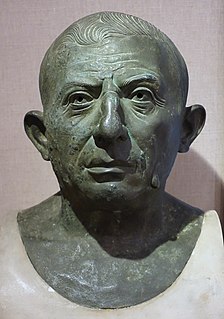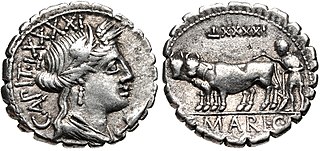Related Research Articles

Gaius Plinius Caecilius Secundus, born Gaius Caecilius or Gaius Caecilius Cilo, better known as Pliny the Younger, was a lawyer, author, and magistrate of Ancient Rome. Pliny's uncle, Pliny the Elder, helped raise and educate him.
The gens Acilia was a plebeian family at ancient Rome, that flourished from the middle of the third century BC until at least the fifth century AD, a period of seven hundred years. The first of the gens to achieve prominence was Gaius Acilius, who was quaestor in 203 and tribune of the plebs in 197 BC.
Manius Laberius Maximus was a Roman senator and general, who was active during the reign of Domitian and Trajan. He was twice consul: the first time he was suffect consul in the nundinium of September to December 89 AD as the colleague of Aulus Vicirius Proculus; the second time as ordinary consul in 103 as colleague to the Emperor Trajan.

The Oxyrhynchus Papyri are a group of manuscripts discovered during the late nineteenth and early twentieth centuries by papyrologists Bernard Pyne Grenfell and Arthur Surridge Hunt at an ancient rubbish dump near Oxyrhynchus in Egypt.
Papyrus Oxyrhynchus 658 is one of four examples of libelli found at Oxyrhynchus in Egypt. The last lines of the manuscript declare the date — the first year of the emperor Decius, whose full name was Gaius Messius Quintus Traianus Decius. We know the first year of his reign was 250 AD.

The gens Vibia was a plebeian family at ancient Rome. Although individuals named Vibius appear in history during the time of the Second Punic War, no members of this gens are found at Rome until the final century of the Republic. The first of the Vibii to obtain the consulship was Gaius Vibius Pansa in 43 BC, and from then until imperial times the Vibii regularly filled the highest offices of the Roman state. The emperors Trebonianus Gallus and Volusianus each claimed descent from the family.

The gens Caecilia was a plebeian family at ancient Rome. Members of this gens are mentioned in history as early as the fifth century BC, but the first of the Caecilii who obtained the consulship was Lucius Caecilius Metellus Denter, in 284 BC. The Caecilii Metelli were one of the most powerful families of the late Republic, from the decades before the First Punic War down to the time of Augustus.
The gens Caecinia was a plebeian family of Etruscan origin at ancient Rome. Members of this gens are first mentioned in the time of Cicero, and they remained prominent through the first century of the Empire, before fading into obscurity in the time of the Flavian emperors. A family of this name rose to prominence once more at the beginning of the fifth century.

The gens Maria was a plebeian family of Rome. Its most celebrated member was Gaius Marius, one of the greatest generals of antiquity, and seven times consul.
The gens Septimia was a minor plebeian family at ancient Rome. The gens first appears in history towards the close of the Republic, and they did not achieve much importance until the latter half of the second century, when Lucius Septimius Severus obtained the imperial dignity.
Papyrus Oxyrhynchus 53 is a report on a persea tree, written in Greek. The manuscript was written on papyrus in the form of a sheet. It was discovered by Grenfell and Hunt in 1897 in Oxyrhynchus. The document was written on 25 February 316. It is housed in the British Museum. The text was published by Grenfell and Hunt in 1898.
Papyrus Oxyrhynchus 56 is a letter requesting the appointment of a guardian, written in Greek. The manuscript was written on papyrus in the form of a sheet. It was discovered by Grenfell and Hunt in 1897 in Oxyrhynchus. The document was written on 28 October 203. It is housed in the Cambridge University Library. The text was published by Grenfell and Hunt in 1898.
Papyrus Oxyrhynchus 58 is a letter concerning the appointment of treasury officials, written in Greek. The manuscript was written on papyrus in the form of a sheet. It was discovered by Grenfell and Hunt in 1897 in Oxyrhynchus. The document was written on 13 September 288. It is housed in the British Library (752). The text was published by Grenfell and Hunt in 1898.
Papyrus Oxyrhynchus 87 is a declaration on oath by a ship owner, written in Greek. The manuscript was written on papyrus in the form of a sheet. It was discovered in Oxyrhynchus. The document was written between 25 February and 26 March 342. Currently it is housed in the Sackler Library in Oxford.
Papyrus Oxyrhynchus 95 is an agreement for the sale of a slave, written in Greek. It was discovered in Oxyrhynchus. The manuscript was written on papyrus in the form of a sheet. The document was written on 23 June 129. Currently it is housed in the library of the Royal Holloway College in Egham.
Papyrus Oxyrhynchus 120 contains two letters, written in Greek and discovered in Oxyrhynchus. The manuscript was written on papyrus in the form of a sheet. The document was written in the 4th century. Currently it is housed at Haileybury College in Hertford Heath.
Papyrus Oxyrhynchus 125 is a declaration on oath, written in Greek and discovered in Oxyrhynchus. The manuscript was written on papyrus in the form of a sheet. The document was written on 13 December 560. Currently it is housed in the Egyptian Museum (10062) in Cairo.
The gens Rutilia was a plebeian family at ancient Rome. Members of this gens appear in history beginning in the second century BC. The first to obtain the consulship was Publius Rutilius Rufus in 105 BC.
Gaius Pompeius Planta was a Roman eques who was a close associate of the emperor Trajan. He is best known for being praefectus or governor of Roman Egypt, which he held from 98 to 100 AD.
Titus Longaeus Rufus was a Roman eques who is known to have held imperial appointments during the reign of the Emperor Commodus. He is known from inscriptions and surviving documents written on papyrus.
References
- 1 2 3 A. N. Sherwin-White, The letters of Pliny: a historical and social commentary (Oxford: Clarendon Press, 1966), p. 210
- ↑ Statius, Silvae, iv.7
- ↑ Guido Bastianini, "Lista dei prefetti d'Egitto dal 30a al 299p", Zeitschrift für Papyrologie und Epigraphik , 17 (1975), p. 280
- ↑ Pliny, Epistulae , iii.2
- ↑ Papyrus Londinium , 904. English translation in A. S. Hunt and C.C. Edgar, Select Papyri, II. Non-literary Papyri. Public Documents (London: Loeb, 1932), pp. 108f. Apographa is the same term that is used in the Gospel of Luke (2:1-4) to refer to the census conducted at the time of the birth of Christ.
- ↑ Papyrus Oxyrhynchus , xxxviii.2852
- ↑ CIL III, 38
- ↑ Pliny, Epistulae, ix.1